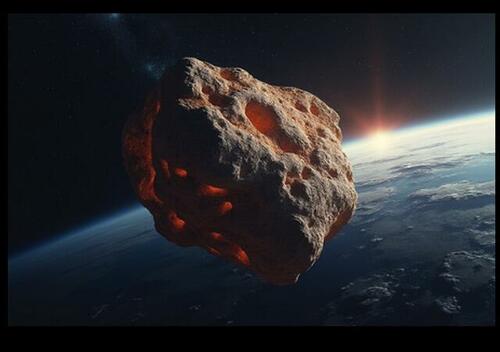Authored by Leslie Eastman via LegalInsurrection.com,
Asteroid Apophis, named after the Egyptian god of chaos and destruction, is a near-Earth asteroid that has garnered significant attention due to its close approach to our home planet.
Discovered in 2004, Apophis is classified as a potentially hazardous object. Due to swing close enough to the planet in 2029, the gravitational influence will be enough to cause tremors.
A recent study led by Ronald-Louis Ballouz from Johns Hopkins University Applied Physics Laboratory suggests that the asteroid 99942 Apophis may experience tremors—similar to earthquakes—due to Earth’s gravitational pull during its close flyby on April 13, 2029, with simulations indicating significant surface changes.
Apophis, approximately 340 meters in size, will pass within about 32,000 kilometers of Earth, closer than many satellites in orbit.
When Apophis was discovered on June 19, 2004, by Roy Tucker, David Tholen, and Fabrizio Bernardi during the University of Hawaii Asteroid Survey (UHAS), initial calculations indicated that it could approach Earth with a risk of collision, especially during its pass in 2029. It didn’t help that it is named after the Egyptian god of darkness and chaos.
The original estimates for collision were as high as 2.7%, and Apophis achieved the highest rating ever on the ‘Torino scale’ – a method used to evaluate the threat that an asteroid poses to Earth.
However, new calculations and observations have led scientists to conclude that there will be no impact….for at least 100 years.
….Using the data available at the time, astronomers believed that there was a chance that the flyby could alter the trajectory of Apophis in a way that would line it up for a collision with Earth in 2068.
However, radar observations of Apophis made by NASA’s Goldstone Deep Space Communications Complex in California and the Green Bank Observatory, West Virginia, in March 2021 greatly improved our knowledge of the asteroid’s current orbit and allowed astronomers to finally rule out any chance of Earth impact for at least 100 years.
And while it won’t strike Earth, Apophis will be bright enough in the skies to be visible to the unaided eye. So, the viewing parties could be fun!
As I mentioned, the viewing parties of the National Aeronautics and Space Administration (NASA) are currently making their own plans for up-close-and-personal observations.
The OSIRIS-APEX mission is slated to visit the asteroid. It continues the OSIRIS-REx mission, which successfully collected and returned samples from asteroid Bennu (which I reported on in a 2023 post).
OSIRIS-APEX is a mission to study the physical changes to asteroid Apophis that will result from its rare close encounter with Earth in April 2029. That year, Apophis’ orbit will bring it within 20,000 miles (32,000 kilometers) of Earth’s surface — closer to Earth than our highest-altitude satellites. Our planet’s gravitational pull is expected to alter the asteroid’s orbit, change how fast it spins on its axis, and possibly cause quakes or landslides that will alter its surface.
OSIRIS-APEX will allow scientists on Earth to observe these changes. Additionally, the OSIRIS-APEX spacecraft will dip toward the surface of Apophis – a “stony” asteroid made of silicate (or rocky) material and a mixture of metallic nickel and iron – and fire its engines to kick up loose rocks and dust. This maneuver will give scientists a peek at the composition of material just below the asteroid’s surface.
Other satellite projects, including those related to planetary defense, are also being planned.
Under the auspicious “NEAlight” project, a team from Julius-Maximilians-Universität Würzburg (JMU) and led by space engineer Hakan Kayal has revealed three concepts for such spacecraft. Each of the suggested satellites will aim to exploit this asteroid passage because Earth experiences just once such event every millennium.
The goal? To collect data that could help scientists better understand the solar system, and perhaps even aid in the development of defense measures against dangerous asteroids.
